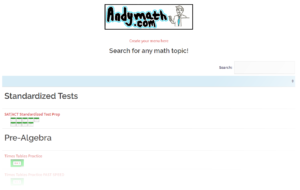Notes
Left Riemann Sum
\(\displaystyle\int _a^b f(x)\,\)\(dx \approx \frac{b-a}{n} \cdot \left[f(a)+f\left(x_1\right)+f\left(x_2\right)+…+f\left(x_{n-1}\right)\right]\)
Right Riemann Sum
\(\displaystyle\int _a^b f(x)\,\)\(dx \approx \frac{b-a}{n} \cdot \left[f\left(x_1\right)+f\left(x_2\right)+…+f\left(x_{n-1}\right)+f(b)\right]\)
Midpoint Riemann Sum
\(\displaystyle\int _a^b f(x)\,\)\(dx \approx \frac{b-a}{n} \cdot \left[f\left(\frac{a+x_1}{2}\right)+f\left(\frac{x_1+x_2}{2}\right)+…+f\left(\frac{x_{n-1}+b}{2}\right)\right]\)
| \({\text{Overestimates and Underestimates}}\) | ||
| \(\) | \(\underline{\text{Increasing Interval}}\) | \(\underline{\text{Decreasing Interval}}\) |
|---|---|---|
Practice Questions
Solve each integral using Riemann sums with n subintervals.
\(\textbf{1)}\) Approximate using a Left Riemann sum with n=5
\(\displaystyle\int_{2}^{7}x^2 \,dx \,\,\, \)
\(\textbf{2)}\) Approximate using a Midpoint Riemann sum with n=3
\(\displaystyle\int_{0}^{6}x^3 \,dx \,\,\, \)
\(\textbf{3)}\) Approximate using a Right Riemann sum with n=4
\(\displaystyle\int_{0}^{2\pi}\sin{x} \,dx \,\,\, n=4 \)
\(\textbf{4)}\) Approximate using a Left Riemann sum with n=4
\(\displaystyle\int_{0}^{2}5-x^2 \,dx \,\,\, n=4 \)
\(\textbf{5)}\) Approximate using a Right Riemann sum with n=4
\(\displaystyle\int_{1}^{5}\displaystyle \frac{1}{x+2} \,dx \,\,\, n=4 \)
\(\textbf{6)}\) Approximate using a Midpoint Riemann sum with n=4
\(\displaystyle\int_{1}^{3}x \sin{x} \,dx \,\,\, n=4 \)
\(\textbf{7)}\) Approximate using a Left Riemann sum with n=4
\(\displaystyle\int_{0}^{6}\sqrt{x^2+4} \,dx \,\,\, n=4 \)
See Related Pages\(\)
\(\bullet\text{ Calculus Homepage}\)
\(\,\,\,\,\,\,\,\,\text{All the Best Topics…}\)
\(\bullet\text{ Properties of Integrals}\)
\(\,\,\,\,\,\,\,\,\displaystyle \int_{a}^{b}cf(x) \, dx=c\displaystyle \int_{a}^{b}f(x) \,dx…\)
\(\bullet\text{ Indefinite Integrals- Power Rule}\)
\(\,\,\,\,\,\,\,\,\displaystyle \int x^n \, dx = \displaystyle \frac{x^{n+1}}{n+1}+C…\)
\(\bullet\text{ Indefinite Integrals- Trig Functions}\)
\(\,\,\,\,\,\,\,\,\displaystyle \int \cos{x} \, dx=\sin{x}+C…\)
\(\bullet\text{ Definite Integrals}\)
\(\,\,\,\,\,\,\,\,\displaystyle \int_{5}^{7} x^3 \, dx…\)
\(\bullet\text{ Integration by Substitution}\)
\(\,\,\,\,\,\,\,\,\displaystyle \int (x^2+3)^3(2x) \,dx…\)
\(\bullet\text{ Area of Region Between Two Curves}\)
\(\,\,\,\,\,\,\,\,A=\displaystyle \int_{a}^{b}\left[f(x)-g(x)\right]\,dx…\)
\(\bullet\text{ Arc Length}\)
\(\,\,\,\,\,\,\,\,\displaystyle \int_{a}^{b}\sqrt{1+\left[f'(x)\right]^2} \,dx…\)
\(\bullet\text{ Average Function Value}\)
\(\,\,\,\,\,\,\,\,\displaystyle\frac{1}{b-a} \int_{a}^{b}f(x) \,dx\)
\(\bullet\text{ Volume by Cross Sections}\)
\(\,\,\,\,\,\,\,\,\)
\(\bullet\text{ Disk Method}\)
\(\,\,\,\,\,\,\,\,V=\displaystyle \int_{a}^{b}\left[f(x)\right]^2\,dx…\)
\(\bullet\text{ Cylindrical Shells}\)
\(\,\,\,\,\,\,\,\,V=2 \pi \displaystyle \int_{a}^{b} y f(y) \, dy…\)
\(\bullet\text{ Andymath Homepage}\)
In Summary
Riemann sums are a mathematical concept used to approximate the area under a curve or the value of a definite integral. They are named after mathematician Bernhard Riemann, who introduced them in the 19th century.
To define Riemann sums, we start by dividing the region under the curve into a series of smaller rectangles. The height of each rectangle is determined by the value of the function at a specific point, and the width is determined by the size of the partition. The sum of the areas of all the rectangles is called a Riemann sum.
We learn about Riemann sums because they provide a way to approximate definite integrals, which are important in many areas of mathematics and physics. Riemann sums also give us a way to understand the concept of limits and how they relate to integration.
Riemann sums are typically covered in a calculus course.
Related topics to Riemann sums include definite integrals, limits, and multivariable calculus. These topics are often studied together and build upon each other, with Riemann sums serving as an important stepping stone in the development of more advanced mathematical concepts.
Interesting uses for Riemann Sums
Estimating the area of a region: Riemann sums can be used to estimate the area of a region by dividing the region into small rectangles and summing the areas of the rectangles. For example, if you wanted to estimate the area of a circular region, you could divide the region into a large number of small sectors and sum the areas of the sectors to get an approximation of the total area.
Calculating the volume of a solid: Riemann sums can also be used to calculate the volume of a solid by dividing the solid into small cubes and summing the volumes of the cubes. For example, if you wanted to calculate the volume of a cylinder, you could divide the cylinder into a large number of small cylinders and sum the volumes of the small cylinders to get an approximation of the total volume.
Estimating the length of a curve: Riemann sums can be used to estimate the length of a curve by dividing the curve into small segments and summing the lengths of the segments. For example, if you wanted to estimate the length of a curve traced out by a particle moving along a path, you could divide the path into a large number of small segments and sum the lengths of the segments to get an approximation of the total length.
Calculating the average value of a function: Riemann sums can be used to calculate the average value of a function over a given interval by dividing the interval into small subintervals and summing the values of the function at the midpoints of the subintervals. For example, if you wanted to calculate the average temperature over a given period of time, you could divide the time interval into small subintervals and sum the temperatures at the midpoints of the subintervals to get an approximation of the average temperature.
Andymath.com is a free math website with the mission of helping students, teachers and tutors find helpful notes, useful sample problems with answers including step by step solutions, and other related materials to supplement classroom learning. If you have any requests for additional content, please contact Andy at tutoring@andymath.com. He will promptly add the content.
Topics cover Elementary Math, Middle School, Algebra, Geometry, Algebra 2/Pre-calculus/Trig, Calculus and Probability/Statistics. In the future, I hope to add Physics and Linear Algebra content.
Visit me on Youtube, Tiktok, Instagram and Facebook. Andymath content has a unique approach to presenting mathematics. The clear explanations, strong visuals mixed with dry humor regularly get millions of views. We are open to collaborations of all types, please contact Andy at tutoring@andymath.com for all enquiries. To offer financial support, visit my Patreon page. Let’s help students understand the math way of thinking!
Thank you for visiting. How exciting!
